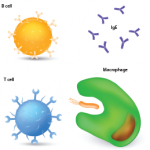New data shed more light on the contributions of B cells to the pathology of systemic lupus erythematosus (SLE). The data suggest that active SLE is the result of newly generated antibody-secreting cell (ASC) populations that undergo extensive polyclonal expansion. It is not yet clear whether the polyclonal ASCs are generated by the activation of bystander B cells or by the stimulation of multiple lupus autoantigens.
On May 25, Christopher M. Tipton, PhD, an instructor of medicine at Emory University in Atlanta, and colleagues published the results of their deep sequencing, proteomic profiling of autoantibodies online in Nature Immunology.1 They evaluated peripheral blood ASCs from patients with SLE who had minimal immunosuppression and were experiencing a disease flare. Cells from these patients were compared with peripheral blood ASCs from vaccinated healthy control subjects. The investigators sorted and sequenced the rearranged genes, encoding antibody heavy chains from ASCs, naive cells and IgD memory cells. They also measured clonal size, the contribution of large clones and repertoire diversity.
The researchers found that naive B cells were highly polyclonal in patients with SLE, as well as in vaccinated controls. In the case of patients with SLE, however, the polyclonal repertoire of the ASCs included abnormally expanded clones selected from a much smaller fraction of cells than those found in vaccinated healthy control subjects. Moreover, a substantial percentage of ASCs from patients with SLE were derived from newly activated naive cells that had persisted in the circulation for several months. SLE flares corresponded with the activation and diversification of these naive B cells (acN). Thus, the selection of SLE autoreactivities involved prolonged recruitment and polyclonal activation of recently activated naive B cells.
“Our study of SLE has delineated the connectivity among B cell subsets during an ongoing autoimmune response. Indeed, a relevant observation was that the two major subsets of circulating ASCs (CD138− ASCs and the more mature CD138+ ASCs) were highly interconnected and represented newly produced proliferative plasmablasts in the process of ongoing maturation,” wrote the authors. They went on to suggest that the population expansion may reflect a recall response to chronic exposure to autoantigens. The study was not designed, however, to identify the autoantigens targeted by the ASC oligoclonal expansion during SLE flares.
Further, the authors explain, “Our results provide new insight into the phenotype, magnitude and downstream consequences of the activation of naive B cells in SLE. Indeed, the previously recognized population expansion of CD21lo activated B cells was ascribed to CD27+ B cells, while other studies did not discriminate among transitional and/or recent immigrant and mature naive B cell subsets, a limitation overcome by incorporation of the analysis of MTG [MitoTracker Green] staining and CD24 expression. Also in contrast with published studies, in our experiments, acN cells were CD23−, a finding consistent with the downregulation of CD23 expression induced by sustained activation of the BCR [B cell receptor], toll-like receptor 9 and interferon-α and interferon-γ, all important stimulatory pathways in SLE.”
